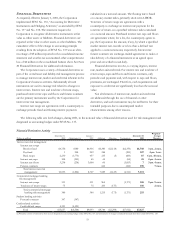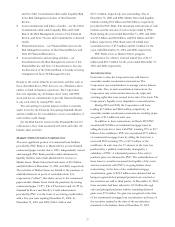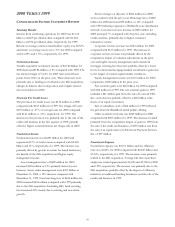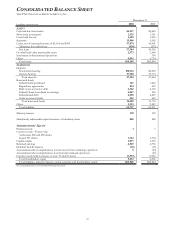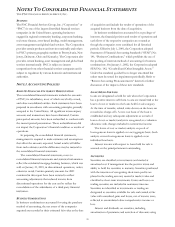PNC Bank 2001 Annual Report Download - page 59
Download and view the complete annual report
Please find page 59 of the 2001 PNC Bank annual report below. You can navigate through the pages in the report by either clicking on the pages listed below, or by using the keyword search tool below to find specific information within the annual report.57
and the Other Commitments table under Liquidity Risk
in the Risk Management section of this Financial
Review.
• Loan commitments and letters of credit -- see the Other
Commitments table under Liquidity Risk and Credit
Risk in the Risk Management section of this Financial
Review, and Note 9 Loans and Commitments to Extend
Credit.
• Financial derivatives -- see Financial Derivatives in the
Risk Management section of this Financial Review and
Note 20 Financial Derivatives.
• Loan securitization and servicing activities – see
Securitizations in the Risk Management section of this
Financial Review and Note 14 Securitizations. See also
the discussion of the National Bank of Canada servicing
arrangement in Note 30 Subsequent Events.
Except to the extent inherent in customary activities such as
those described above, PNC does not use off-balance-sheet
entities to fund its business operations. The Corporation
does not capitalize any off-balance-sheet entity with PNC
stock and has no commitments to provide financial backing
to any such entity by issuing PNC stock.
The accounting for special purpose entities is currently
under review by the Financial Accounting Standards Board
and the conditions for consolidation or non-consolidation of
such entities could change.
See the Risk Factors section in this Financial Review for
a discussion of key risks associated with these and other off-
balance-sheet activities.
MARKET STREET FUNDING CORPORATION
The most significant portion of commercial loan facilities
provided by PNC Bank is to Market Street, an asset-backed
commercial paper conduit that is 100% independently owned
and managed. PNC Bank provides credit enhancement,
liquidity facilities and certain administrative services to
Market Street. Market Street had total assets of $5.2 billion
and $4.0 billion at December 31, 2001 and 2000, respectively.
The activities of Market Street are limited to the purchase of
undivided interests in pools of receivables from U.S.
corporations (“sellers”) that desire access to the commercial
paper market. Market Street funds the purchases by issuing
commercial paper (“CP”). The CP has been rated A1/P1 by
Standard & Poor’s and Moody’s. Credit enhancement
provided by PNC is in the form of a revolving credit facility
with a five year term expiring December 31, 2004. At
December 31, 2001 and 2000, $166.1 million and
$115.7 million, respectively, was outstanding. Also at
December 31, 2001 and 2000, Market Street had liquidity
facilities totaling $5.8 billion and $4.5 billion, respectively,
provided by PNC Bank. The maximum total amount of such
facilities and the amount of such total provided by PNC
Bank during the years ended December 31, 2001 and 2000,
was $7.0 billion and $5.8 billion, and $5.2 billion and $4.5
billion, respectively. PNC Bank received related loan
commitment fees of $7.8 million and $6.5 million for the
years ended December 31, 2001 and 2000, respectively.
PNC Bank serves as Market Street’s program
administrator for which it received related fees of $11.7
million and $10.7 million for the years ended December 31,
2001 and 2000, respectively.
SECURITIZATIONS
From time to time the Corporation has sold loans in
secondary market securitization transactions. The
Corporation uses securitizations to manage various balance
sheet risks. Also, in such securitization transactions, the
Corporation may retain certain interest-only strips and
servicing rights that were created in the sale of the loans. The
Corporation’s liquidity is not dependent on securitizations.
During 2001 and 2000, the Corporation sold loans
totaling $1.5 billion and $865 million, respectively, in
secondary market securitization transactions, resulting in pre-
tax gains of $13 million in each year.
In addition to these transactions, in March 2001 PNC
securitized $3.8 billion of residential mortgage loans by
selling the loans into a trust with PNC retaining 99% or $3.7
billion of the certificates. PNC also securitized $175 million
of commercial mortgage loans by selling the loans into a
trust with PNC retaining 99% or $173 million of the
certificates. In each case, the 1% interest in the trust was
purchased by a publicly-traded entity managed by a
subsidiary of PNC. A substantial portion of the entity’s
purchase price was financed by PNC. The reclassification of
these loans to securities increased the liquidity of the assets
and was consistent with PNC’s on-going balance sheet
restructuring. At the time of the residential mortgage
securitization, gains of $25.9 million were deferred and are
being recognized when principal payments are received or
the securities are sold to third parties. At December 31, 2001,
these securities had been reduced to $1.3 billion through
sales and principal payments and the remaining deferred
gains were $7.8 million. No gain was recognized at the time
of the commercial mortgage loan securitization and none of
the securities retained at the time of the securitization
remained on the balance sheet at December 31, 2001.








